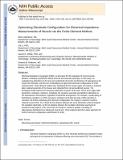Optimizing Electrode Configuration for Electrical Impedance Measurements of Muscle via the Finite Element Method
Author(s)
Jafarpoor, Mina; Jia Li, Mina; White, Jacob K.; Rutkove, Seward B.
DownloadWhite_Optimizing electrode.pdf (2.760Mb)
OPEN_ACCESS_POLICY
Open Access Policy
Creative Commons Attribution-Noncommercial-Share Alike
Terms of use
Metadata
Show full item recordAbstract
Electrical impedance myography (EIM) is a technique for the evaluation of neuromuscular diseases, including amyotrophic lateral sclerosis and muscular dystrophy. In this study, we evaluated how alterations in the size and conductivity of muscle and thickness of subcutaneous fat impact the EIM data, with the aim of identifying an optimized electrode configuration for EIM measurements. Finite element models were developed for the human upper arm based on anatomic data; material properties of the tissues were obtained from rat and published sources. The developed model matched the frequency-dependent character of the data. Of the three major EIM parameters, resistance, reactance, and phase, the reactance was least susceptible to alterations in the subcutaneous fat thickness, regardless of electrode arrangement. For example, a quadrupling of fat thickness resulted in a 375% increase in resistance at 35 kHz but only a 29% reduction in reactance. By further optimizing the electrode configuration, the change in reactance could be reduced to just 0.25%. For a fixed 30 mm distance between the sense electrodes centered between the excitation electrodes, an 80 mm distance between the excitation electrodes was found to provide the best balance, with a less than 1% change in reactance despite a doubling of subcutaneous fat thickness or halving of muscle size. These analyses describe a basic approach for further electrode configuration optimization for EIM.
Date issued
2013-04Department
Massachusetts Institute of Technology. Department of Electrical Engineering and Computer ScienceJournal
IEEE Transactions on Biomedical Engineering
Publisher
Institute of Electrical and Electronics Engineers (IEEE)
Citation
Jafarpoor, Mina, Jia Li, J. K. White, and S. B. Rutkove. “Optimizing Electrode Configuration for Electrical Impedance Measurements of Muscle via the Finite Element Method.” IEEE Trans. Biomed. Eng. 60, no. 5 (May 2013): 1446–1452.
Version: Author's final manuscript
ISSN
0018-9294
1558-2531